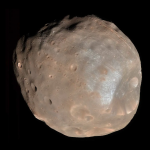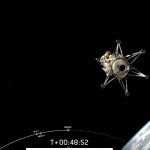
A pioneering NASA 747 aircraft outfitted with a big telescope was retired a couple years ago. But the mission is still making space discoveries.
Scientists used data previously collected by the SOFIA (Stratospheric Observatory for Infrared Astronomy) endeavor to spot evidence of frozen water on two asteroids. It’s more evidence that water is pervasive in our solar system. And the discovery provides astronomers more data in their quest to determine how Earth got its water: Billions of years ago, might an asteroid, or asteroids, have transported water to our planet?
“Asteroids are leftovers from the planetary formation process, so their compositions vary depending on where they formed in the solar nebula,” Anicia Arredondo, an astronomer at the Southwest Research Institute and lead author of the research, said in a statement. “Of particular interest is the distribution of water on asteroids, because that can shed light on how water was delivered to Earth.”
The new research was recently published in the Planetary Science Journal.
SOFIA’s 747 carried a formidable 8.8-foot-wide (2.7-meter) telescope, which viewed a light that we can’t see with the naked eye, called infrared (the powerful James Webb Space Telescope is designed to view infrared light, too). “Many objects in space emit almost all their energy at infrared wavelengths and are often invisible when observed with visible light,” NASA explained. Crucially, the SOFIA craft flew at altitudes of 38,000 to 45,000 feet, largely above the thicker atmosphere that blocks infrared light from reaching the ground.
Famously, SOFIA’s telescope detected water on the sunlit region of the moon, so before the mission retired, NASA turned the telescope towards asteroids, too. Ultimately, two asteroids, hundreds of millions of miles away, showed strong signs of water.
“We detected a feature that is unambiguously attributed to molecular water on the asteroids Iris and Massalia,” Arredondo explained.

Credit: NASA / Carla Thomas / SwRI

Credit: NASA / Jim Ross
If asteroids did indeed deliver water to an early Earth — as opposed to our planet forming with this water as the rocky world coalesced together — it would be little surprise. Bounties of water have been detected on asteroids before. And Ceres, an object in the asteroid belt so large that it’s now considered a “dwarf planet,” may be composed of some 25 percent water.
NASA retired SOFIA to the Pima Air & Space Museum in Tucson. But the most powerful observatory in space, the Webb telescope, may soon turn its eye to dozens of asteroids, which have for billions of years preserved frozen clues, like an expansive cosmic museum, to Earth’s past.















0 Comments